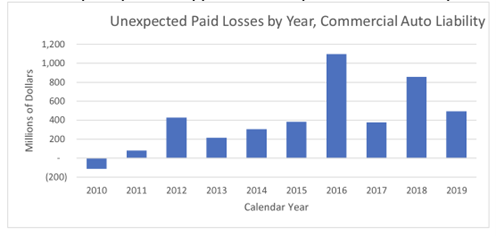KEY TAKEAWAYS:
--Polls indicate inflation is the number one topic on most people's minds, ranking above violent crime and climate change. Insurers must find ways, including through ads, to illustrate the connection between social inflation and price inflation in a manner relatable to most consumers.
--Carriers must design and implement decision models that identify as early as possible when an attorney will appear on a claim. Some adjusters “know” whether a claim will be represented and whether it will go to trial, but data-driven decision systems, especially those developed with advanced AI, can predict litigation for additional claims outside the range of the adjuster’s knowledge.
----------
There are many ways to quantify the impact of attorney involvement and social inflation (of which attorneys are a significant cause) on insurance carriers. One of the most striking examples is featured in a report by Jim Lynch and Dave Moore of the Casualty Actuarial Society, Social Inflation and Loss Development. The report shows what they calculated as the unexpected paid losses each year.
They find "evidence that social inflation in the 2010s caused paid losses to be more than $4 billion higher than predicted with standard loss development techniques,” including more than $1 billion of unexpected paid losses in 2016 alone.

Source: Social Inflation and Loss Development
The social inflation fire is burning hot and bright. Lynch and Moore estimate that social inflation increased commercial auto liability claims by more than $20 billion between 2010 and 2019. There are good reasons to believe it will continue to do so. The “normal” contributors to social inflation — higher litigation rates, higher jury awards and shifting attitudes about corporations — continue to worsen. And now there is more gasoline on the social inflation fire: third-party litigation funding (TPLF).
See also: Time for Summit With Plaintiffs' Lawyers
Third-Party Litigation Funding
Deep-pocketed law firms, hedge funds, wealthy investors and other interested parties are providing funds up front for litigating complex lawsuits. This amount can be, in large cases, tens of millions of dollars. While such arrangements are characterized as a loan, they are not subject to regulation of any kind.
Here’s how it works: The funding entity fronts the money. If the plaintiff wins, the funder receives his “loan” back and a significant share of the remaining settlement as “interest” for taking the risk of losing. The plaintiff must then also pay his attorney and often winds up with less than he most likely would have received through unfunded litigation, including settling out of court.
What’s the attraction to litigation funding from an investor’s perspective? A report issued by Swiss RE stated that rates of return on litigation funds have been as high as 52% in recent years. That’s much better than recent stock market returns. About $2.5 billion was invested in litigation funds in 2020, which grew in 2021. With returns like those, no wonder all sorts of investors are piling in — hedge funds, large law firms and private investors who work with a TPLF broker. Government retirement funds and college endowments indirectly invest in litigation funding through their investments in hedge funds and other “alternative” investments.
Who pays for this? We all do, in the long run. Insurance companies pass most of their costs to policyholders through higher premiums. Companies and enterprises try hard to pass those cost increases on to their customers. It doesn’t happen automatically, but end consumers (all of us) ultimately pay — not just for the plaintiff’s share of the settlement but also the attorneys’ and funders’ fees and the cost of our court system to support frequent and lengthy litigation.
Protect Your Business from Excessive Litigation
What can insurance carriers do to combat this challenge that excessive litigation plays in the industry and society? Here are two ideas.
Minimize the Effects of Social Inflation
When insurance companies talk to consumers, it’s typically through funny TV ads. When “serious issues” are brought forth, consumers don’t engage. Consumers are more receptive to listening to messages about issues affecting them directly and for which they are concerned. Meanwhile, attorneys’ ads discuss “winning big money for you” and “sticking it to the insurance company.” How can insurance companies compete?
One possibility is to associate “social inflation” in insurance with the price inflation consumers are confronted with today. Popular polls indicate inflation is the number one topic on most people's minds, ranking above violent crime and climate change. It shouldn’t be tough to illustrate the connection between social inflation and price inflation in a manner relatable to most consumers.
The insurance industry must experiment more with how to convey its message. Insurance carriers have catchy ads; Why not leverage Patrick Mahomes or a cute gecko to “get serious for a moment”?
See also: Misunderstood Role of the Attorney
Use Data as Your Defense
Because litigators get an early jump on all available data associated with the claim incident, carriers must implement a rigorous and comprehensive litigation analytics strategy to close the gap and take this advantage away.
You should start by making your data more usable: cleansed, standardized and accessible in real time. Then, design and implement decision models that identify as early as possible when an attorney will appear on a claim. (You can develop this in-house, but more and more carriers are looking to partner with companies that have developed, implemented and maintained decision systems like these.) Whichever way you go, you need to get going. “Going” means starting with your data. Dig into it and make it usable.
Some adjusters will tell you they “know” whether a claim will be represented and whether it will go to trial. In many cases, they do. But data-driven decision systems, especially those developed with advanced artificial intelligence, can predict litigation for additional claims outside the range of the adjuster’s knowledge. Information is the oil that keeps the “litigation engine” operating — and when wielded correctly, it can be used to minimize or avoid attorney involvement altogether.
Be Aggressive About the High Cost of Litigation
Carriers can tackle the rising indemnity costs of workers’ compensation and commercial auto claims by staying informed about the current strategies litigants are using to seek payouts and by using the wealth of data they already have to better predict attorney involvement in claims.
As first published in Insurance Innovation Reporter.








